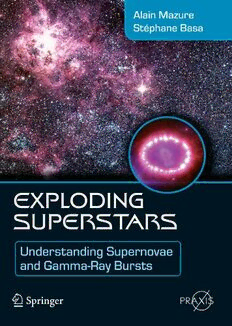
Exploding Superstars: Understanding Supernovae and Gamma-Ray Bursts PDF
158 Pages·2009·4.426 MB·English
Most books are stored in the elastic cloud where traffic is expensive. For this reason, we have a limit on daily download.
Preview Exploding Superstars: Understanding Supernovae and Gamma-Ray Bursts
Description:
In Exploding Superstars, Alain Mazure and Stephane Basa show how great stellar explosions have become extremely important in recent years to cosmologists trying to understand the evolution of our universe since the Big Bang and the scale of that universe. Recently supernovae and gamma-ray bursters have been used, for example, as "standard candles," illuminating their immediate environs like searchlights and allowing us to study the cosmos between them and us. In the first three chapters the authors briefly review the great explosions that will form the subject matter of the book--namely, supernovae and gamma-ray bursters. They describe the very early universe, after the Big Bang, and then how "the lights came on all over the universe as the very first stars began to shine." The importance of stellar mass in governing not only the lifetime of a star (the most massive stars live relatively short lives) but also the way in which a star ends its days is also explained. Chapter 4 describes the explosion of certain massive stars, outlining the various stages at the end of these stars' lives, which result in the cataclysmic explosions known as supernovae. In Chapter 5 the authors introduce the more exotic and spectacular forms of stellar explosion known as gamma-ray bursters. Chapter 6 studies the markers used for cosmic surveys and Hubble's contributions to the field. The penultimate chapter looks at the very distant, highly luminous sources known as quasars and the evolution of our universe from the earliest times. The final chapter shows how observations of distant supernovae have revealed that the expansion of the universe is in fact accelerating--one of the most exciting and remarkable discoveries in recent years. It was this discovery that lead to the idea that 70% of the universe is made up of mysterious dark energy.
See more
The list of books you might like
Most books are stored in the elastic cloud where traffic is expensive. For this reason, we have a limit on daily download.
